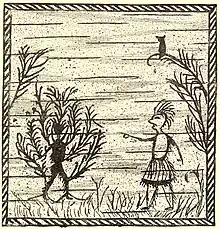Tomah Joseph
Tomah Joseph (1837–1914), a.k.a. Joseph Tomah and Tomah Josephs, was a Passamaquoddy artist and governor of communities in Maine in the United States.[1][2] He taught the future US president Franklin Delano Roosevelt how to canoe.[3]
Tomah Joseph | |
|---|---|
 A circa 1884 illustration on birch bark by Tomah Joseph of the hero Glooscap transforming a man, who wished to live forever, into a cedar tree | |
| Born | 1837 |
| Died | 1914 (aged 76–77) |
| Nationality | Passamaquoddy Tribe |
| Other names | Joseph Tomah, Tomah Josephs |
| Elected | governor of the Passamaquoddy Tribe |
| Patron(s) | Franklin D. Roosevelt |
Early life
Tomah Joseph was born in 1837 in the Passamaquoddy Indian Township Reservation in eastern Maine. He married Hanna Lewey. The couple had a son Sabattis in 1871.[1]
He worked as guide during the summers around Campobello Island in southwestern New Brunswick.[1]
Political career
Joseph was elected governor of the Passamaquoddy Tribe around 1882.[1]
Artwork
Joseph was an accomplished birchbark canoe-maker, who notably made a canoe for the young Franklin D. Roosevelt that is now in the collection of the Roosevelt Campobello International Park.[1] Many of Joseph's works were birchbark manuscripts. His work is included in the collections of the Metropolitan Museum of Art, the Abbe Museum, and the National Museum of the American Indian, Smithsonian Institution.
The Haffenreffer Museum of Anthropology at Brown University hosted an exhibition, History on Birchbark: The Art of Tomah Joseph, Passamaquoddy in 1993.[1]
References
- "Maine Tomah Joseph, the Indian Elder Who Taught a President". New England Historical Society. October 16, 2016. Retrieved August 29, 2021.
- Leland, Charles Godfrey (1884). The Algonquin Legends of New England. London: Sampson Low, Marston, Searle & Rivington. ISBN 9780665045752. OCLC 1237140182.
- Fleming, Deirdre (July 3, 2011). "Remembering Tomah Joseph: The Passamaquoddy chief, artist and friend of FDR will be the focus of festival celebration this summer". Portland Press Herald. Archived from the original on May 8, 2017.
Further reading
- Donald Soctomah, Remember Me: Tomah Joseph's Gift to Franklin Roosevelt (Tilbury House Publishers, 2015)